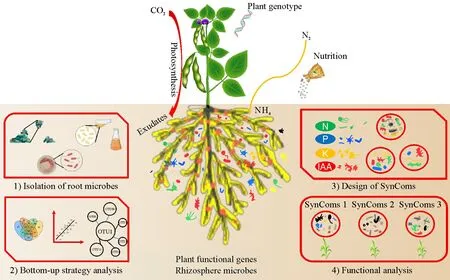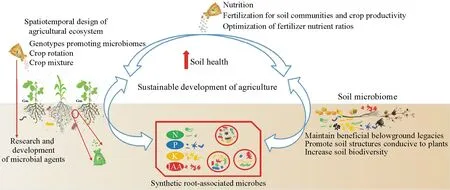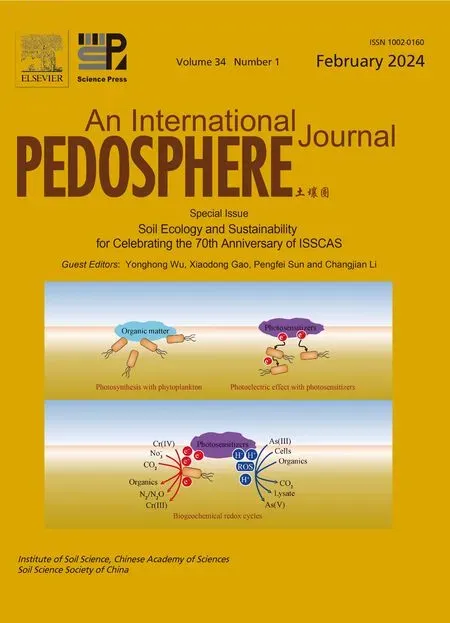Partnering crops with root-associated microbes for soil health and agricultural sustainability
Increasing global demand for food presents a significant challenge to maintaining soil health and sustainable production of agricultural crops.As plant root-associated microbial fitness is greatly impacted by community growth,development,and nutrient acquisition,the cultivation of functional assembly of root-associated microbes may provide solutions for achieving food security while maintaining healthy soils.Here,we propose a four-part strategy to promote soil health and agricultural productivity by partnering crops with root-associated microbes.
The global human population has surpassed 8 billion and is trending towards 9 billion in the coming decades(https://ourworldindata.org/world-population-growth).Historical trends in population growth and development have compelled concomitant increases of 70%-100% in agricultural productivity;however,improving food security and agricultural resilience depends not only on increased productivity,but also on the diversification of production systems(https://www.fao.org/statistics/databases/en/FAO).Continuing current agricultural practices is unlikely to meet these requirements as we have passed the peak of agricultural land use,with both marginal and fertile soils facing degradation and pollution,while extreme weather events,fueled by global warming,are increasing in severity and frequency(Singhet al.,2020).In addition,the excessive application of agrochemicals (e.g.,fertilizers) and the simplification of cropping systems (e.g.,continuous monocropping) in intensively cultivated systems have imparted long-lasting detrimental impacts on soil health(Jinget al.,2022),which we consider here to be the continued ability of soils to sustain the vital life systems of plants,animals,and humans,as previously defined(Doran and Zeiss,2000).In short,the increasing human population world with decreasing availability of fertile land calls for urgent action to achieve food security without sacrificing soil health.
In agricultural systems,soils primarily provide mineral nutrients to crops,which are often the determinants of crop productivity.Soil microbes exert a large influence on crop nutrition by cycling nutrients,decomposing organic matter,and providing numerous other services(Cobanet al.,2022).Therefore,harnessing microbial capabilities may be an innovative approach to simultaneously promote crop productivity and environmental sustainability.A preliminary estimate based on utilizing microbial partners to secure nutrients,protect against pathogens,and resist environmental stresses found that within 20 years of managing crops along with their microbial communities,crop productivity increased by 20%,while fertilizer and pesticide requirements decreased by 20%(Trivediet al.,2020).Although trophic interactions between predatory protists and pathogen-suppressive bacteria have been studied for their impact on plant health (Guoet al.,2022),research on managing microbial communities remains sparse beyond limited inquiries into how they respond to environmental changes(Schimel,2018).There are few reports on the use of soil microbes to develop new natural products or as part of cropping systems that incorporate traditional agricultural practices.
Roots are known to release specific organic compounds into rhizosphere to stimulate the dissolution of otherwise insoluble minerals and decompose recalcitrant organic matter.This phenomenon has been labelled the rhizosphere priming effect,which is a major driving force for nutrient cycling and soil organic matter turnover(Wanget al.,2016;Yinet al.,2018;Sunet al.,2021).Rhizosphere microbiomes,also known as the second genome of plants,harbor cohorts of bacterial,fungal,and oomycete representatives,which are indispensable for plant growth and soil health(Mueller and Sachs,2015;De Vrieset al.,2020;Trivediet al.,2020).The odds of successful coexistence throughout plant microbiomes have been enhanced by the evolutionary selection of multiple interactions between plant species and their microbial cohorts(Zhanget al.,2017).Rather than being a collection of many independent taxa,plant root-associated microbial communities are complex webs of interactions in a particular ecosystem where resource competition,symbiosis,community sensing,and horizontal gene transfer may all be manifest(Trivediet al.,2020).In recent years,synthetic communities(SynComs)of varying complexity have been constructed using“bottom-up”combinations of microbial species and applied to plant hosts to study the mechanisms that drive community assembly,as well as the interactions among different community members that impact host productivity(Vorholtet al.,2017).One emerging conclusion appears to be that increasing species richness and extending metabolic diversity promote the hosts’adaptability to shifting and stressful environments(Coyteet al.,2015).A more granular resolution of the species involved and the underlying mechanisms can pave the way for the managed production of beneficial microbial cohorts along with novel microbial fertilizer products.Based on these analyses,synthetic and natural assembly of root-associated microbes needs to be further investigated for their impacts on agricultural productivity and soil health,with the development of novel SynComs aiming to achieve food security without sacrificing soil health.To this end,we propose a four-part strategy for identifying promising members of plant microbiomes and constructing effective SynComs(Fig.1).The four parts of the strategy are outlined as follows.

Fig.1 Four-part strategy for partnering crops with root-associated microbes for soil health and agriculture sustainability:1)large-scale isolation,purification,and identification of microbes through high-throughput bacterial cultivation,2)“bottom-up”research strategy to construct candidate synthetic communities(SynComs),3)design of SynComs with beneficial impacts on soil health and crop production,and 4)validation of putatively beneficial SynComs on soil health and agriculture sustainability.IAA=indole acetic acid.
The first part is large-scale isolation,purification,and identification of microbes through high-throughput cultivation of crop root and rhizosphere bacteria under various conditions.Although thousands of cultivated microbes have been isolated and stored in international stock centers(Zouet al.,2019),these microbes have been obtained separately from various environments and/or host species,and specific adaptations to local conditions may yield insights into a limited set of interactions with other components of native microbiomes (Liuet al.,2019).In recent years,several studies have indicated that the selection of root-associated microbes often depends on host genotype and environmental conditions.For example,the assembly of soybean rhizobacterial communities was found to be highly influenced by both the host plant genotype and the introduction of exogenous rhizobia(Zhonget al.,2019).Therefore,large-scale isolation,purification,and identification of microbes from the roots and rhizosphere of different crops under different conditions are a prerequisite for producing plant-associated communities optimized for both crop yield and soil health.
The second part is“bottom-up”research approaches for developing candidate SynComs.Preliminary testing of Syn-Coms can be conducted in axenic systems using pure culture strains applied in accordance with the observed natural microbiome patterns to test for relationships between microbes of SynComs and plant phenotypes(Kwaket al.,2018),to compare root microbiome effects between wild-type and mutant plants(Lebeiset al.,2015),and/or to conduct network analysis (Duránet al.,2018).Significant challenges exist when conducting these experiments in comprehensive highthroughput settings.For example,many microbes have yet to be cultivated under axenic conditions under which they may not express the desired phenotypes.Therefore,“bottom-up”research approaches are recommended to obtain individual members of microbiomes,reconstruct metabolic networks,and guide the design of functional SynComs(Lawsonet al.,2019).Functional testing of different microbial organization schemes can be performed sequentially until consistent implementation of target functionalities is verified in SynComs.As candidate SynComs are developed,they need to be tested in competition with indigenous soil microflora over a representative range of locations.As SynComs are established,fundamental aspects of rhizosphere processes remain to be elucidated,such as identifying plant-microbe recognition factors and determining the mechanisms and targets of plantdriven selection.Addressing these fundamental knowledge gaps will be instrumental in the successful application of SynComs in practical farming operations.
The third part is design of SynComs with beneficial effects on soil health and crop production.Microbial strains may be screened and categorized according to their nutritional functions,such as phosphorus solubilization,nitrogen fixation,potassium release,and growth promotion capacity(e.g.,indole acetic acid secretion).For soils with particular challenges,screening of functional strains needs to be specifically targeted.For example,in saline soils,screening probiotic bacteria for 1-aminocyclopropane-1-carboxylic acid deaminase activity may open new paths to effectively mitigate salt stress effect on crop growth(Glick,2014).The probiotic functions of single strains need to be tested on host plants,along with the relationships between microbial strains (Duránet al.,2018).With sufficient testing,cropspecific functional SynComs can then be constructed by combining single bacterial strains according to their individual contributions to the combined impacts on targeted crop phenotypes and soil health issues.One successful application of SynComs has been reported for soybean,where selected SynComs promoting the acquisition of nitrogen and phosphorus both indoors and in the field increased yields by up to 36.1%in field trials(Wanget al.,2021).
The fourth part is validation of putatively beneficial SynComs in trials covering representative conditions(i.e.,field and indoor trials) to test for effects on crop nutrient acquisition efficiency and productivity,as well as soil health.Different crop genotypes may exhibit variations in microbial flora preference,even within the same soil environment.Moreover,the biggest current obstacles for application of effective microbial fertilizers in field settings are the specificity,stability,and efficiency of the selected microbial strains.Therefore,the effects of specific soil types and host genotypes on the stable survival of culturable bacteria need to be considered.In addition,to produce effective SynComs with long-term stability,it will be necessary to improve the understanding of relevant aspects of microbial ecology,such as the dynamic construction mechanisms underlying microbial community development.The reward for producing stable cohorts of beneficial microbes for applications in field settings will be the minimized dependence of modern agriculture on chemical fertilizers and pesticides while improving soil fertility and crop productivity.
Concludingremarks andfuture challenges.As resource shortages and negative environmental effects of chemical fertilizers increase,the urgency to reduce chemical fertilizer usage intensifies.According to nutrient restitution principles,soil fertility cannot be maintained unless the nutrients taken up by crops are restored to the soil.Therefore,microbial methods cannot replace application of chemical fertilizers,although they can be employed to reduce the use of chemical fertilizers and,to a certain extent,promote cycling of soil nutrients.The main challenge now is to utilize soil microbes in modern agricultural systems to enhance plant nutrient acquisition,which would allow growers to reduce chemical fertilizer applications and improve nutrient use efficiency while also maintaining,or even improving,soil health.To this end,culturable soil microbes can be incorporated into SynComs,while beneficial unculturable microbes can be promoted through the diversification of intercropping patterns to improve the diversity of soil ecosystem services.To fully capitalize the potential benefits of applying SynComs in agricultural settings,it will be necessary to not only include root-associated microbes in crop management plans,but also select crop genotypes optimized for microbiome development,diversify crops for soil health management,apply inputs to enhance favorable microbiomes,and manage cropping systems for soil and microbiome health.Development of the strategies outlined herein opens possibilities for managing production environments to create positive above-and belowground legacies that yield high-quality and nutritious food while fostering healthy soils(Fig.2).Overall,soil memory and positive soil legacy management,selection and breeding of green manure varieties or genotypes with excellent fertilization characteristics,and enrichment of beneficial microbes in soils can all be considered strategies to improve crop productivity and enhance food security.Finally,integrating the concept of SynComs into traditional organic production schemes may enhance soil biodiversity,maintain soil health,improve disease resistance,and increase crop productivity.At the very least,there is growing evidence that application of beneficial microbes can increase nitrogen and phosphorous use efficiency and reduce greenhouse gas emissions(Govindarajuluet al.,2005;Benderet al.,2014;Bender and Van Der Heijden,2015;Cavagnaroet al.,2015).Therefore,exploring and utilizing plant-microbe interactions and Syn-Coms promises to be a rewarding strategy for harnessing the power of beneficial microbes and embracing soil health and sustainable agriculture.

Fig.2 Optimized agricultural management consisting of selection of crop species/genotypes that enhance microbiome impacts,diversification of crops,application of inputs for crops and soil microbiomes,and managing of soils for both crops and microbiomes to create positive above-and belowground legacies that can influence the production of high-quality and nutritious food while fostering healthy soils.IAA=indole acetic acid.
ACKNOWLEDGEMENTS
We acknowledge the support from the National Key Research and Development Program of China(No.2021YFF-1000500).We thank Dr.Thomas Walk,Golden Fidelity LLC,USA,for English editing.
- Pedosphere的其它文章
- Removal of atmospheric methane by soil ecosystems and its controlling variables from microbial to global scales
- Preface:Special issue on soil ecology and sustainability for celebrating the 70thanniversary of ISSCAS
- Responses of nitrogen cycling and related microorganisms to brackish wetlands formed by evapotranspiration
- Assessment of soil total phosphorus storage in a complex topography along China’s southeast coast based on multiple mapping scales
- Application of controlled-release urea increases maize N uptake,environmental benefits and economic returns via optimizing temporal and spatial distributions of soil mineral N
- Effects of herbicide butachlor application on the growth of periphytic biofilms and nitrogen loss in paddy systems

